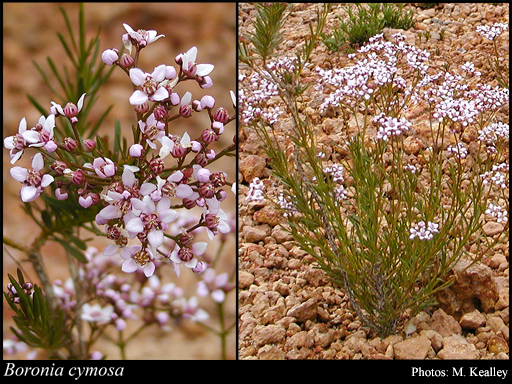- Reference
- Endl., Fenzl, Benth. & Schott, Enum.Pl. 16 (1837)
- Conservation Code
- Not threatened
- Naturalised Status
- Native to Western Australia
- Name Status
- Current
Erect shrub, 0.2-0.6 m high. Fl. pink, Feb or May or Jul to Nov. Sandy often gravelly soils. Granite outcrops, rocky hillsides, sandplains.

Scientific Description
Shrub, spines absent; branchlets smooth, without distinct raised glands, +/- cylindrical in cross-section, glabrous. Leaves opposite, simple, 15-42 mm long, 0.4-1 mm wide, flat, the margins revolute, smooth, without distinct raised glands, glabrous; stipular excrescences absent. Flowers in terminal, loose clusters (cymes or panicles); pedicels 3-4 mm long; calyx present, 3-4 mm long, smooth, without distinct raised glands, glabrous; corolla pink, petals four, 6-8.5 mm long, imbricate (overlapping), free, glabrous; stamens twice as many as petals, 2-2.5 mm long, warty with prominent raised glands, hairy, with an appendage. Flowers in February, May, July, August, September, October and November. Occurs in the Eremaean and South-West Botanical Province, in the Carnarvon, Yalgoo, Avon Wheatbelt, Jarrah Forest, Swan Coastal Plain and Geraldton IBRA region(s).
Distribution
- IBRA Regions
- Avon Wheatbelt, Carnarvon, Geraldton Sandplains, Jarrah Forest, Swan Coastal Plain, Yalgoo.
- IBRA Subregions
- Edel, Geraldton Hills, Lesueur Sandplain, Merredin, Northern Jarrah Forest, Perth, Wooramel.
- IMCRA Regions
- Central West Coast.
- Local Government Areas (LGAs)
- Canning, Chapman Valley, Coorow, Dandaragan, Gosnells, Greater Geraldton, Irwin, Kalamunda, Mundaring, Northampton, Shark Bay, Swan, Three Springs.